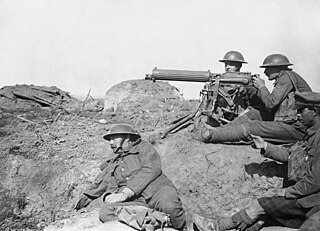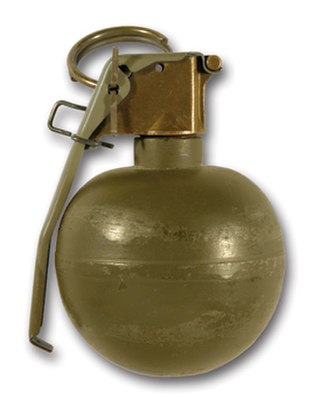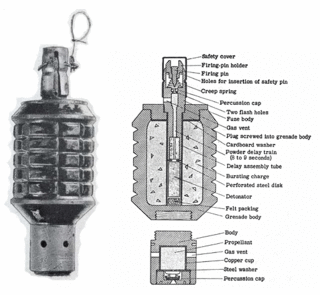| No. 1 grenade | |
|---|---|
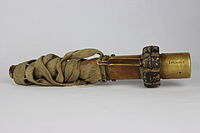 Hand grenade No. 1 Mark I | |
| Type | Hand grenade |
| Place of origin | United Kingdom |
| Service history | |
| Used by | United Kingdom |
| Wars | World War I |
| Production history | |
| Designer | Royal Laboratories |
| Designed | 1908 |
| Produced | 1908-1915 |
| Variants | No. 3 (shorter handle), No. 18 (different detonator) |
| Specifications | |
| Mass | 2 lb (0.9 kg) [1] |
| Filling | Lyddite [1] [ full citation needed ] |
Detonation mechanism | Percussion fuse (impact detonated) |
The grenade, hand No. 1 was the first British hand grenade used in World War I. It was designed in the Royal Laboratory, based on reports and samples of Japanese hand grenades during the Russo-Japanese War provided by General Sir Aylmer Haldane, who was a British observer of that war. [2]

World War I, also known as the First World War or the Great War, was a global war originating in Europe that lasted from 28 July 1914 to 11 November 1918. Contemporaneously described as "the war to end all wars", it led to the mobilisation of more than 70 million military personnel, including 60 million Europeans, making it one of the largest wars in history. It is also one of the deadliest conflicts in history, with an estimated nine million combatants and seven million civilian deaths as a direct result of the war, while resulting genocides and the 1918 influenza pandemic caused another 50 to 100 million deaths worldwide.

The Russo-Japanese War was fought during 1904-1905 between the Russian Empire and the Empire of Japan over rival imperial ambitions in Manchuria and Korea. The major theatres of operations were the Liaodong Peninsula and Mukden in Southern Manchuria and the seas around Korea, Japan and the Yellow Sea.
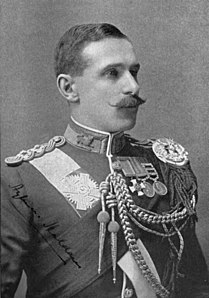
General Sir James Aylmer Lowthorpe Haldane, was a senior British Army officer with a long and distinguished career.
Contents

The grenade proper is a container of explosive material with an iron fragmentation band. The fuse was of the impact sort, detonating when the top of the grenade hit the ground. A long cane handle (approximately 16 inches or 40 cm) allowed the user to throw the grenade further than the blast of the explosion.

Fragmentation is the process by which the casing of a projectile from a bomb, barrel bomb, land mine, IED, artillery, mortar, tank gun, or autocannon shell, rocket, missile, grenade, land mine, etc. is shattered by the detonation of the explosive filler.

In an explosive, pyrotechnic device, or military munition, a fuse is the part of the device that initiates function. In common usage, the word fuse is used indiscriminately. However, when being specific, the term fuse describes a simple pyrotechnic initiating device, like the cord on a firecracker whereas the term fuze is sometimes used when referring to a more sophisticated ignition device incorporating mechanical and/or electronic components, such as a proximity fuze for an M107 artillery shell, magnetic or acoustic fuze on a sea mine, spring-loaded grenade fuze, pencil detonator, or anti-handling device.
To ensure that the grenade hit the ground nose first, a cloth streamer was attached to the end of the handle. When thrown, this unfurled and acted as a tail to stabilize flight. The grenade came with a metal loop so it could hang from a belt.




